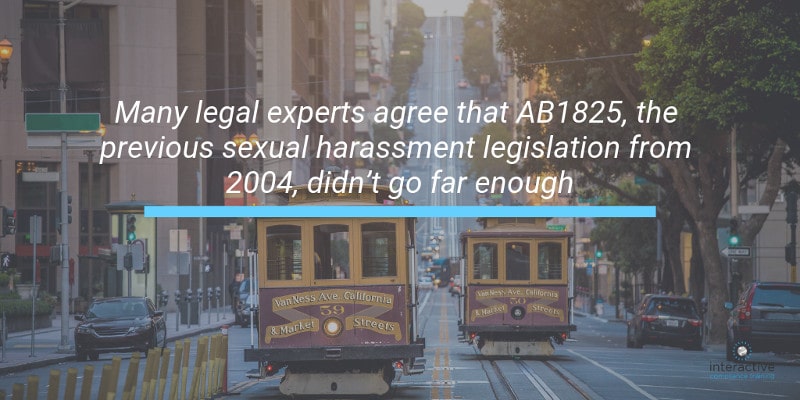From Hollywood to Silicon Valley, California companies have frequently made headlines for incidents of sexual harassment and sexual assault. But the culture of “boys will be boys”, prevalent in tech companies and the entertainment industry, is being challenged on a number of fronts. The toxic culture which has been tolerated, and even facilitated, in these industries is facing increasing scrutiny and legislative pressure.
In September 2018, California Governor, Jerry Brown, signed into law a series of bills designed to more effectively prevent and eliminate sexual misconduct in the workplace. The #MeToo movement has been the driving force behind California’s legislative mandate to increase employers’ obligations to protect California employees from illegal harassment.
Many legal experts agree that AB1825, the previous sexual harassment legislation from 2004, didn’t go far enough. According to the California Employment Lawyers Association and Equal Rights Advocates, the legislation allowed sexual harassers to get away with “one free grope” without facing legal liability. Unless a victim could prove the harassment had been severe or pervasive, a single incident didn’t typically amount to harassment. But California’s new workplace sexual harassment legislation sends a strong message to employers and employees alike that such behavior will no longer be tolerated. Not even once.
Starting on January 1st, 2019, California law essentially says: No free gropes.
Training Requirements of SB1343
SB1343 modifies AB1825. It constitutes one of the most sweeping collections of laws on the topic. The bill increases legal protections for workplace harassment victims, while also expanding employers’ responsibility for preventing sexual harassment and increasing the legal liability for perpetrators of sexual misconduct. Included in employers’ duties are much broader training requirements.
California employers with five or more employees must provide harassment prevention training to all employees. Prior to SB1343, California employers were required to train just their managers—typically about 25 percent of the workforce. Under the new law, they must train 100 percent of the workforce. Around 92 percent of the state’s workforce—an estimated 15.5 million workers—will now receive sexual harassment training biennially.
What are the specifics of the new legislation related to training?
The training:
• Must occur between January 1st, 2019 and December 31st, 2019 to be compliant with the January 1st, 2020 deadline.
• Must include at least two hours of sexual harassment prevention training for all supervisors.
• Must include at least one hour of sexual harassment prevention training for all nonsupervisory employees.
• Temporary and seasonal workers employed for fewer than six months must be trained by the employer within 30 calendar days after the hire date or within 100 hours worked, whichever occurs first. If the employees are provided through a third-party temporary services employer, the training must be provided by the temporary services employer.
• Must occur within six months of new employees starting their jobs (and once every two years thereafter).
• May incorporate bystander intervention training. This training demonstrates how to intervene at an event, party, or other setting that presents a problematic situation that may result in sexual harassment or assault, with the intention of preventing the situation from escalating.
• Should inform employees that their identities may not be protected if they engage in acts that constitute harassment.

Training Content
Companies that plan to create their own training or purchase content must consider that the mandate requires sexual harassment curricula to include information about the federal and statewide ban on sexual harassment, practical steps for sexual harassment prevention, abusive conduct prevention, corrective actions against harassers, and remedies available to victims of harassment. Training must also include practical examples of harassment on the basis of sexual orientation, gender expression, and gender identity. It should also address discrimination, retaliation, and abusive conduct.
Acceptable Modes of Training
The passage of the new legislation requires California employers to deploy training to a much wider audience. They may need to consider new ways of delivering training beyond instructor-led, such as eLearning and webinars, which allow for more flexibility in training delivery.
Employers will be permitted to develop their own training curricula and platforms, as long as they comply with the law’s requirements. The training may be completed individually or as part of a group session and may also take place in shorter segments if the hourly requirements are met. Each mode of training must provide an opportunity for the attendee to obtain answers to questions within two business days of the training. Tracking new hires and promotions is imperative to compliance.
Other methods of interactive training, such as the use of audio or video, are only viewed as supplemental tools that alone do not fulfill the requirements. They may, however, be used in conjunction with instructor-led, eLearning, and/or webinar training.
If this new legislation impacts your company, start planning now by nailing down your design, delivery strategy, and training rollout schedule. January 1st, 2020 will be here before you know it.
View Sexual Harassment Training Requirements in US states
